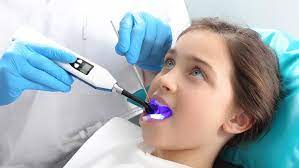It’s becoming increasingly difficult to detect tooth decay in the mouths of Americans. Why? The fluoride that’s widely used in drinking water and toothpastes hardens tooth enamel. Tooth decay, consequently, is forced to find microscopic tears in this enamel. Once these tears are found, the decay quickly spreads itself into the softer surface underneath. Seemingly healthy teeth, even according to conventional X-ray machine results, can hide (in the minds of some dentists) what’s hidden underneath the surface.
It’s believed by some that most tooth decay is not evident to dentists until it’s one-third the width of the tooth. The tooth filling that such a large dental cavity requires can weaken the tooth structure and ultimately cause a never-ending cycle of dental problems. Early cavity detection may mean less repair work and better enamel integrity. Historically, dentists have relied on probing teeth with fine picks and taking X-rays every few dental visits; this method is effective in finding only 57 percent of cavities, and by contrast, the laser cavity detector is believed to be 90 percent accurate in finding dental cavities or suspicious areas.
High Performance Laser Cavity Detection
Laser cavity detection is based on the fact that healthy tooth structure reflects light differently than it does decayed tooth structure. More simply, light easily penetrates healthy teeth. And on the flipside, light has a tougher time passing through dental cavities.
Dentists perform laser cavity detection by beaming laser light onto the chewing area of your teeth. The pen-like instrument that’s used to probe the mouth in laser cavity detection is similar to a light wand. As your dentist scans the chewing area of your teeth with this light wand, the attached readout portion of the laser cavity detection machine checks the density of your tooth structure and calculates the possibility of tooth decay. When increased light wavelengths register, your dentist is notified of a possibly compromised area from the readout, as well as the machine’s auditory signaling system.
Early dental cavity detection means that in some cases, dentists can actually prevent the onslaught of cavities. When they find weak areas, fluoride may be prescribed to do battle with the would-be dental cavity, stopping it from ever forming. If a dental cavity is found before it invades the tooth’s dentin (softer tissue below surface enamel) a dental sealant is sometimes indicated or, if necessary, a dental filling may be the prescribed course of dental treatment.
Things to Consider About Laser Cavity Detection
Some of you may know people (you may even be one of these people!) who have had differing cavity counts between dentists who use traditional X-rays and those who use laser cavity detection. While the machinery is indeed different, the real difference lies in the dentist who operates that machinery. One dentist may decide that treatment is in order for a vulnerable area that can only be seen using laser cavity detection, another dentist may see the same area and decide to leave it alone, and another dentist may rely on traditional X-ray machines because of a belief about when dental cavities should be treated.
If your dentist offers both traditional X-rays and laser cavity detection, open a discussion about the best choice for you. The price between the two shouldn’t differ, but early dental cavity detection can mean money saved. On the flip side, there is sometimes an issue of how early is too early: When in doubt, ask questions. A dentist will be happy to answer them.

